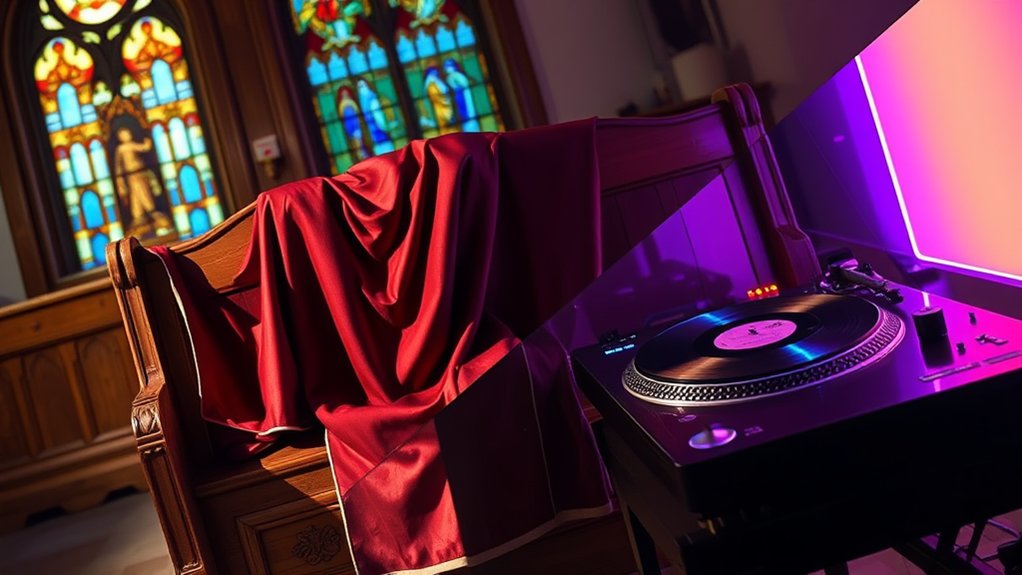Key Takeaways
- Gospel music has its origins in the spirituals sung by slaves in the 18th century, influencing numerous artists and musical styles over time.
- Trap music emerged from the streets of Atlanta, characterized by themes of survival and hustle.
- Both gospel and trap music carry significant cultural importance, reflecting their distinct historical contexts.
From Spirituals to Modern Beats: A Musical Evolution
Did you know that gospel music traces its roots back to the powerful spirituals sung by slaves in the 18th century? This genre has shaped music for generations, influencing countless artists and styles along the way.
On the other hand, trap music, born in the vibrant streets of Atlanta, tells tales of survival and hustle.
Both genres resonate with deep cultural significance, but how did we get from worship songs to the iconic beats of trap? Let's explore the journey.
The Origins and Development of Gospel Music
Gospel music has a rich and powerful history that begins with the emotional and resonant songs sung by Africans during the slavery era. You'll find that spirituals were much more than songs; they were a vital form of spiritual expression, capturing the hardships and hopes for freedom. These melodies, deeply rooted in Christian teachings, spoke of struggles and aspirations through powerful biblical stories. As Africans interacted with European settlers, a cultural exchange occurred. They adapted European hymns using African rhythms, creating a unique musical adaptation that laid the foundation for gospel music. Churches became the heartbeat of this movement, transforming spirituals into profound sources of strength. With the end of slavery, spirituals traveled north with migrating communities, evolving into what you now recognize as gospel music. Additionally, the introduction of singing schools in the 1720s played a role in shifting singing methods, which influenced the development of gospel music further.
Gospel's Crossover Into Mainstream Influence
When you think about the blend of gospel music into mainstream sounds, it's a powerful story of influence and transformation.
Gospel's crossover success began with Edwin Hawkins' "Oh Happy Day" in 1968, paving the way for genre blending across music worlds. Artists like Sam Cooke led the charge by moving from gospel roots to impact soul music widely.
Kirk Franklin and Tamela Mann continued this legacy by crafting compelling sounds that resonated across R&B and hip-hop realms.
Gospel's influence ripples through R&B and soul, thanks to legends like Ray Charles and Aretha Franklin who wove gospel elements into popular songs.
This genre blending expands gospel's cultural reach, touching hearts in broader audiences and enriching our shared musical heritage. You can't overlook this beautiful fusion!
A Deep Dive Into Trap Music's Beginnings
As you explore the rich tapestry of music's evolution, you'll see how genres overlap and influence each other in powerful ways. Trap music's origins trace back to the early 1990s in Atlanta. Here, "trap houses" inspired the genre's gritty name, reflecting urban struggles. The music's early artists like T.I. and Gucci Mane depicted these harsh realities with their lyrics.
| Feature | Details |
|---|---|
| Early Development | Evolved from Southern hip-hop |
| Key Locations | Atlanta, Georgia |
| Influential Artists | T.I., Gucci Mane |
| Notable Producers | DJ Toomp, Shawty Redd |
| Sound | Heavy bass, hi-hat rhythms, synths |
Producers like DJ Toomp shaped trap's signature sound, while T.I.'s "Trap Muzik" defined its style. Trap music's gritty beats and bold lyrics still resonate today.
The Cultural Impact of Gospel and Trap
While music constantly evolves, both gospel and trap music stand out for their cultural impact and representation within communities.
Gospel influence permeates social movements, providing anthems that sparked change and unity. You can feel its power in iconic film moments or when inspired artists blend soul, rock, and R&B, thanks to its deep roots. Engaging in community activities around music genres like gospel allows them to reinforce shared interests and build trust among groups.
Trap storytelling captures urban life's rawness, echoing realities often overlooked, giving voice to those seeking recognition. It's a modern narrative that connects with the youth, reflecting struggles and triumphs in urban environments.
Both genres offer more than tunes—they're historic voices and contemporary chronicles. Whether through gospel's spiritual expression or trap's gritty tales, they drive cultural discourse, forging connections and promoting economic optimism.
Playing a crucial role in urban politics, these music genres not only shape cultural landscapes but also influence significant socio-political shifts.
Conclusion
Harnessing the Power of Music's Evolution
As you've explored the dynamic landscape of music, from the uplifting harmonies of gospel to the unfiltered essence of trap, it's clear these genres are more than just auditory experiences; they are the living stories of communities. Gospel offers a beacon of hope, while trap delivers raw narratives of resilience. Together, they exemplify music's incredible ability to connect us, ignite inspiration, and fuel transformation in unexpected ways. So, why not dive deeper into these genres? Let their rhythms inspire change and connect with others who share your passion for music's transformative power.










